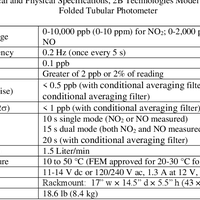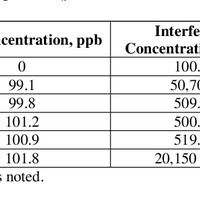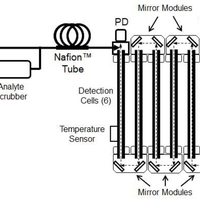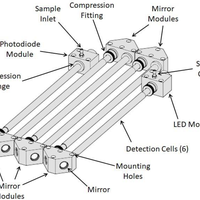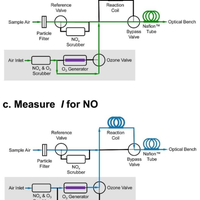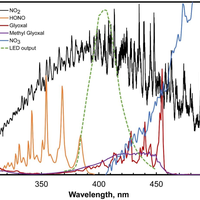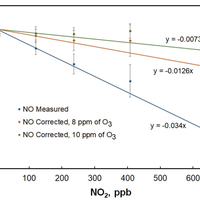Abstract
We describe and characterize a modular folded tubular photometer for making direct measurements of the concentrations of nitrogen dioxide (NO2) and specify how this method could be extended to measure other pollutants such as sulfur dioxide (SO2), ozone (O3), and black carbon particulate matter. Direct absorbance measurements using this photometer can be made across the spectral range from the ultraviolet (UV) to the near infrared. The absorbance cell makes use of modular components (tubular detection cells and mirror cubes) that allow construction of path lengths of up to 2ĝ€m or more while maintaining low cell volumes. The long path lengths and low cell volumes enable sensitive detection of ambient air pollutants down to low part-per-billion levels for gas species and aerosol extinctions down to 1ĝ€Mmĝ'1, corresponding to ĝ1/4 ĝ€0.1ĝ€μgĝ€mĝ'3 for black carbon particulates. Pressure equalization throughout the stages of the absorbance measurement is shown to be critical to accurate measurements of analyte concentrations. The present paper describes the application of this photometer to direct measurements of nitrogen dioxide (NO2) and the incorporation of design features that also enable measurement of nitric oxide (NO) in the same instrument. Excellent agreement for ambient measurements along an urban roadside was found for both NO2 and NO measured by the folded tubular photometer compared to existing standard techniques. Compared to commonly used methods for measurements of NO x species, the advantages of this approach include (1) an absolute quantification for NO2 based on the Beer-Lambert law, thereby greatly reducing the frequency at which calibrations are required; (2) the direct measurement of NO2 concentration without prior conversion to NO as is required for the commonly used chemiluminescence method; (3) the use of modular components that allow construction of absorbance detection cells of varying lengths for extending the dynamic range of concentrations that can be measured; (4) a more economical instrument than other currently available direct measurement techniques for NO2; and (5) the potential for simultaneous detection of additional species such as SO2, O3, and black carbon in the same instrument. In contrast to other commercially available direct NO2 measurements, such as cavity-attenuated phase-shift spectroscopy (CAPS), the folded tubular photometer also measures NO simultaneously in the same apparatus by quantitatively converting NO to NO2 with ozone, which is then detected by direct absorbance.
Figures
Register to see more suggestions
Mendeley helps you to discover research relevant for your work.
Cite
CITATION STYLE
Birks, J. W., Andersen, P. C., Williford, C. J., Turnipseed, A. A., Strunk, S. E., Ennis, C. A., & Mattson, E. (2018). Folded tubular photometer for atmospheric measurements of NO2 and NO. Atmospheric Measurement Techniques, 11(5), 2821–2835. https://doi.org/10.5194/amt-11-2821-2018

